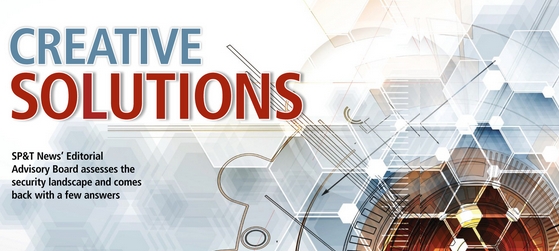
Features
Business & Marketing
Creative solutions: SP&T News’ Editorial Advisory Board insight
SP&T News asked its new-look Editorial Advisory Board to answer a simple two-part question: What are the biggest challenges currently facing Canada’s security installer community and where do the greatest opportunities for future success lie?
May 26, 2017 By Neil Sutton

The answers, of course, were anything but simple. Canada’s security industry (indeed, the global security outlook) is undergoing transformation — in some ways radical. What hasn’t really changed is the end goal of serving the customer (although they have changed too). Common themes include the impact of IT in security, challenges in finding and training qualified personnel, and finding new and more effective ways to collaborate with partners throughout the security ecosystem. Read on for more.
Sam Shalaby, CEO, Feenics Inc.
The security industry’s evolution to new technology has lagged behind other business sectors, but now it’s gaining speed rapidly. This has security companies and technicians struggling to evolve, while trying to develop and attract talent with skills in information technology, Cloud computing and mobility. Their business models need to change — from project-based to managed service revenues — and for many it’s a formidable challenge and completely different from what they’ve done in the past.
Because the security industry is primarily comprised of companies with one to 50 employees, they often focus solely on day-to-day operations rather than developing new core competencies. In addition, the end-user has become highly educated on technology and wants installing companies that can provide new platforms to assist with security and business operations. That’s another challenge and opportunity — to be on the cutting edge and offer services and technologies others aren’t providing. It adds tremendous value and a market differentiator to the installing company.
The security industry needs to embrace technology rather than avoid it. Once they have this mindset, they will be able to create new channels of business and client-based services. This fundamental change shift requires a commitment by both manufacturers and dealers. Manufacturers have a responsibility to assist ineducating and training dealers to develop skills for the future, while the installation community needs to align themselves with vendors who want to help them make the transition. Collaboration and partnership between manufacturers and security companies will bring future success.
Bob Moore, Canada Country Manager, Axis Communications
The biggest challenge currently facing the security industry in Canada is education for new employees and existing security professionals. The lack of a formal educational system to get our security professionals well versed in the latest technologies and solutions makes it hard for employers to find qualified employees. Finding qualified people who are up-to-date on the latest solutions, and have the talent to hit the ground running, is a constant battle. Finding the right fit, with the right knowledge and skills, means a well-run team and a customer base that is well-served with the best possible solutions for their unique needs.
This reality translates to the biggest opportunity facing us in this industry, which is for us all to remain as flexible and versatile as security, building automation, VoIP, intrusion and other solutions are converging as former analogue driven solutions are completely transitioning to IP. This convergence is creating opportunities for those who master adjacent, new technologies that can widen their business offering to their clients.
Antoinette Modica, General Manager, Tech Systems Of Canada Inc.
Meeting clients’ expectations can be a big challenge today because there is no room for error. Because security equipment has become very sophisticated, clients may demand more today than they did previously. Not to mention, due to possible security breaches and threats, the security director has more accountability for the entire security system. Lack of exceptional support can keep any security director up at night.
So, what then is the definition of Exceptional Customer Service? Exceptional Customer Service is an extremely critical part of maintaining ongoing client relationships, along with generating referral business, all of which results in increased revenue.
A security integrators’ employees must take ownership — they must adapt quickly to clients’ needs by responding with highly trained and certified team members, no matter where their client resides. An important factor is ensuring employees become empowered to make the right decision for the client, right at the front line. This requires that everyone in the company becomes accountable.
The key is making investments in skills development such as conflict resolution and strong communication. Courtesy and empathy are other important attributes of a successful customer service representative.
Because the security arena is 24/7, it is vital that, when problems arise, clients receive timely responses. Prompt attention is critical to maintaining good relations with the client, which then develops into a reputation for trustworthy and reliable service. This type of Exceptional Customer Service keeps customers coming back.
Roger Miller, President, Northeastern Protection Service Inc.
As security professionals, we want to offer our clients the best solution for their needs, not ours. Because the security industry serves such a diverse client base, it means we have to build relationships with manufacturers, distributors and marketing firms so we are fluent in the products we are offering or installing. Buying “off the shelf” is not that simple anymore.
The continued integration of security and IT infrastructure in commercial environments means that system designers, security installers and sales teams must have an understanding of network systems so we can maintain compliance in an already crowded space. This applies to highly technical commercial installations as well as smaller residential applications. From integrated industrial facilities to smart home installations, almost everything we work with is travelling on an Internet or local network. This consumes more planning time than ever before. Learning about bandwidth, POE capabilities/restrictions, cabling and network traffic takes the traditional installer outside of their traditional role. Finding qualified personnel becomes more difficult as the industry evolves.
The future for success in the security installation sector is finding the right mix of skilled people to work with advanced technology that will have the ability to understand and meet the complex needs of our clients.
Colin Doe, CEO, Veridin Systems
Security technology has evolved dramatically since I joined the security industry in the early 90s. Risks in the past tended to be physical and local in nature and the threats more easily identified. Today, we live and work in a completely connected environment. Dangers exist across town, across the country and globally. The subject of those risks could be a connected “kid” down the street, or a rogue government or terrorist organization halfway around the world.
Today, with the proliferation of smart phones, connected devices, networks, IOT (Internet of Things) and more to come, the biggest risks are no longer right next door and they are no longer easy to spot, let alone defend against. Critical infrastructure such as our power grid, water supply, and communications networks are potentially vulnerable to cyber-terrorist attacks through command and control system vulnerabilities. I think that future technological advances in the security sector will still revolve around connectivity, but manufacturers and security industry personnel will be using AI as a front line defense against as yet-to-be identified threats. New tools with artificial intelligence capabilities will be needed to create the next level of cyber-security. “Next Level” AI capabilities will be able to identify, compartmentalize and respond to threats long before human interaction has even identified an event as a threat. I think that this will be where the next evolution of technological advance will occur to keep us safe.
Print this page
Advertisement
- Stretching the dollar
- Go West: One of the industry’s most prominent trade events continues to be a barometer for technology trends





